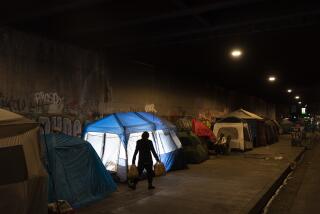Racial Segregation Itself Remains a Corrosive Force : Blacks Held Back by Isolation Within Cities
- Share via
Most people realize that America’s large metropolitan areas are racially segregated. Although this fact is widely admitted, few appreciate the depth of racial segregation in America or realize its pernicious consequences for blacks. Policy-makers, business leaders and foundation strategists accept segregation as part of the nature of things and formulate policies to attack class-based issues among blacks: poverty, family disruption, teen-age pregnancy, crime and drug abuse. While not denying the importance of these problems, racial segregation must itself be acknowledged as a social problem, since it is a major factor behind the perpetuation of these social ills.
Segregation has multiple dimensions and may occur in several different ways: Blacks may be unevenly distributed among neighborhoods; they may live in neighborhoods that are racially isolated; they may be concentrated within small, physically compact areas; they may live in neighborhoods that are clustered together to form one large ghetto, or they may reside in centralized neighborhoods close to the urban core.
In Los Angeles and nine other metropolitan areas, blacks are highly segregated on at least four of these five dimensions of segregation, a pattern I have called “hypersegregation.” Together these metropolitan areas--Baltimore, Chicago, Gary, Cleveland, Detroit, Los Angeles, Milwaukee, Newark, Philadelphia and St. Louis--contain roughly a quarter of the black population of the United States. Hypersegregation denotes a profound and unparallel level of isolation from the mainstream of American society. Latinos, by contrast, are not hypersegregated in any urban area; in Los Angeles they are not highly segregated on any dimension at all.
Many believe that this pattern reflects class-deprivation among blacks. They believe that unemployment, family disruption and out-of-wedlock childbearing keep black families mired in poverty and unable to accumulate the financial resources to leave the ghetto. If the right policy formula could be found to move black families up the socioeconomic ladder, the theory goes, segregation would take care of itself. Unfortunately, this idea is wrong. The level of black segregation changes very little as one moves up the ladder: At all levels of education, income and occupational status, blacks are very highly segregated from whites. In fact, blacks earning more than $50,000 per year are more segregated than Latinos earning under $2,500.
Socioeconomic factors cannot explain black hypersegregation. Rather, the extremity of black segregation is explained by the persistence of white prejudice against blacks, which leads to discrimination against black home seekers in the housing market, discrimination against black borrowers in the lending market and a general tendency for whites to avoid neighborhoods with black residents. The continuation of discrimination and the persistence of white apprehensions about integration have been well-documented by a variety of studies.
Extreme levels of racial segregation have serious negative consequences for black households struggling to escape poverty, since residential mobility is a major avenue of social mobility. Society’s opportunities, resources and benefits are distributed unevenly in cities. Some neighborhoods have good schools, strong ties to employers, excellent services, low crime rates and a youth culture that stresses educational achievement and delayed parenthood; other neighborhoods do not. Families attempt to improve their socioeconomic prospects by moving to better neighborhoods.
For most ethnic groups, socioeconomic mobility is a cumulative process whereby economic advancement (a better job, a raise) is translated into residential progress (a higher-status neighborhood with better schools, peer influences and social contacts), which in turn leads to additional socioeconomic gains (children receive better educations and get better jobs). This avenue for cumulative socioeconomic advancement is largely closed to blacks because of racial barriers to residential mobility.
Segregation also leaves blacks uniquely vulnerable to the effects of economic downturns. During the 1970s and early ‘80s, urban America was buffeted by recessions and inflation. Unemployment rose, wages fell and the value of public-assistance benefits declined. These trends hit urban blacks particularly hard, and over the decade their poverty rates soared. Because of hypersegregation, virtually all of this increase in poverty was absorbed by a small number of isolated black neighborhoods. As a result, the level of black poverty concentration skyrocketed. The economic foundations of community life had changed; poor blacks increasingly lived in neighborhoods where joblessness, poverty, unwed parenthood, crime and delinquency were the norm.
Segregation was directly responsible for the emergence of this new, concentrated form of urban poverty. It represents a primary structural factor behind the creation of the underclass. As the Kerner Commission predicted in 1968, racial segregation has created two fundamentally different socioeconomic environments--one advantaged and white and the other disadvantaged and black. As long as public policies ignore the impact of involuntary racial segregation and focus exclusively on class-related problems among blacks, they will fail because these problems are caused, in large part, by the persistence of racial segregation in American society.


